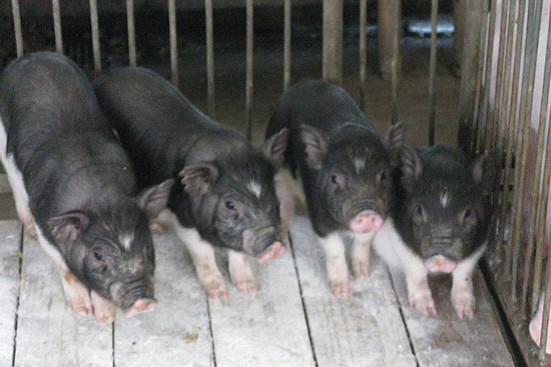分享到
China’s First Genetically Modified Pig for Pig-to-human Xenotransplantation
A research team led by Dr. PAN Deng-ke with the Institute of Animal Science, CAAS successfully developed genetically modified pigs by using knocking out technique on the genes causing hyperacute xenograft rejection in pig-to-human xenotransplantation in wild type pigs. It makes China become one of the few counties with mastery of this technique. Following the United States, Japan and Australia, Chinese scientists are now one big step closer to the breeding of xenotransplantaiton pigs.
In many cases, organ transplantation cannot be applied due to lack of organ donors, causing many deaths from organ failure. Every year, out of the 1.5 million waiting for organs, only 10,000 can receive transplantation therapy in China. Xenotransplantation is an effective way to make up the gap. Pigs are the ideal donor for xenotransplantation for human beings. However, the first difficulty to overcome is the hyperacute immune rejection against pig organs transplanted in human body. α1, 3-galactose antigens, the product of genes encoding α1, 3-galactosyl-transferase (α1, 3GT), is the main cause of the rejection. Using somatic cell gene knock-out and cloning technologies, Dr. Pan Dengke, together with other researchers, developed pigs against hyperacute immune rejection and completed their molecular identification.
According to a senior research fellow from CAAS, materials used in this study are inbred Wuzhishan miniature pigs, which have similar anatomic structure, metabolic mechanism and organ development with human beings. With the advantage of high homozygosity, genetic stability, phenotypic uniformity and clear genetic background, inbred pigs are the ideal experimental material for gene modification for xenotransplantation to human beings before clinical application.

Inbred Wuzhishan miniature pigs
In many cases, organ transplantation cannot be applied due to lack of organ donors, causing many deaths from organ failure. Every year, out of the 1.5 million waiting for organs, only 10,000 can receive transplantation therapy in China. Xenotransplantation is an effective way to make up the gap. Pigs are the ideal donor for xenotransplantation for human beings. However, the first difficulty to overcome is the hyperacute immune rejection against pig organs transplanted in human body. α1, 3-galactose antigens, the product of genes encoding α1, 3-galactosyl-transferase (α1, 3GT), is the main cause of the rejection. Using somatic cell gene knock-out and cloning technologies, Dr. Pan Dengke, together with other researchers, developed pigs against hyperacute immune rejection and completed their molecular identification.
According to a senior research fellow from CAAS, materials used in this study are inbred Wuzhishan miniature pigs, which have similar anatomic structure, metabolic mechanism and organ development with human beings. With the advantage of high homozygosity, genetic stability, phenotypic uniformity and clear genetic background, inbred pigs are the ideal experimental material for gene modification for xenotransplantation to human beings before clinical application.

Inbred Wuzhishan miniature pigs
Latest News
-
 Apr 18, 2024Opening Ceremony of the Training Workshop on Wheat Head Scab Resistance Breeding and Pest Control in Africa Held in CAAS
Apr 18, 2024Opening Ceremony of the Training Workshop on Wheat Head Scab Resistance Breeding and Pest Control in Africa Held in CAAS -
 Apr 03, 2024IPPCAAS Co-organized the Training Workshop on Management and Application of Biopesticides in Nepal
Apr 03, 2024IPPCAAS Co-organized the Training Workshop on Management and Application of Biopesticides in Nepal -
 Mar 28, 2024Delegation from the School of Agriculture and Food Science of University College Dublin, Ireland Visit to IAS, CAAS
Mar 28, 2024Delegation from the School of Agriculture and Food Science of University College Dublin, Ireland Visit to IAS, CAAS -
 Mar 25, 2024Director of World Food Prize Foundation visited GSCAAS
Mar 25, 2024Director of World Food Prize Foundation visited GSCAAS -
 Mar 20, 2024Institute of Crop Sciences (ICS) and Syngenta Group Global Seeds Advance Collaborative Research in the Seed Industry
Mar 20, 2024Institute of Crop Sciences (ICS) and Syngenta Group Global Seeds Advance Collaborative Research in the Seed Industry
